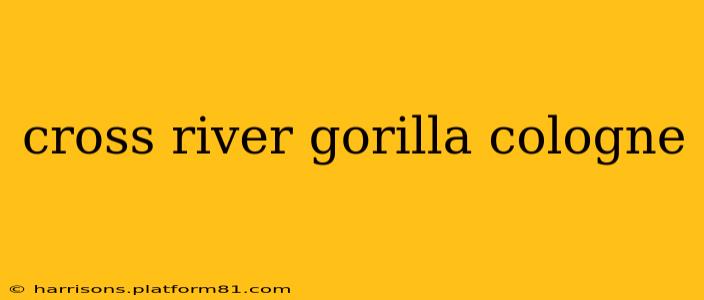The Cross River gorilla, a critically endangered primate found in the rainforests of Nigeria and Cameroon, is a symbol of both fragility and resilience. Its plight has inspired many conservation efforts, and now, surprisingly, a cologne. While a cologne directly featuring the gorilla might seem unusual, the idea taps into the growing trend of using fragrance to raise awareness and support for environmental causes. Let's explore what a hypothetical "Cross River Gorilla Cologne" might entail, its potential impact, and the ethical considerations surrounding such a product.
What would a Cross River Gorilla Cologne smell like?
This is where creativity comes into play. A successful scent would need to evoke the lush rainforest habitat of the Cross River gorilla. Imagine notes of:
- Top notes: The vibrant, zesty freshness of citrus fruits, perhaps a hint of bergamot or lime, mirroring the bright sunlight filtering through the rainforest canopy.
- Heart notes: Rich, earthy scents of damp soil, moss, and lush green vegetation, representing the rainforest floor and undergrowth. A touch of spicy ginger or cardamom could add depth and complexity.
- Base notes: Warm, woody notes of cedarwood, sandalwood, and perhaps a hint of vetiver, reflecting the ancient trees that form the gorilla's habitat. A subtle, musky undertone could subtly suggest the gorilla itself, but done tastefully to avoid offense.
The overall scent profile should be sophisticated, natural, and evocative, capturing the essence of the gorilla's environment without being overly literal or gimmicky.
How could a Cross River Gorilla Cologne support conservation?
A well-executed "Cross River Gorilla Cologne" could be more than just a fragrance; it could be a powerful tool for conservation. Here are some potential avenues:
- Direct donations: A portion of the proceeds from each sale could be directly donated to organizations working to protect Cross River gorillas and their habitat.
- Raising awareness: The unique concept of the cologne could spark conversations and raise awareness of the gorilla's plight among a wider audience. The marketing campaign could effectively highlight conservation challenges and the importance of protecting these magnificent creatures.
- Sustainable practices: The cologne's production could incorporate sustainable and ethically sourced ingredients, further reinforcing the conservation message.
Are there ethical concerns surrounding a Cross River Gorilla Cologne?
It's crucial to address potential ethical concerns. The key is to avoid any suggestion of exploiting or trivializing the gorillas themselves. The marketing must be carefully crafted to emphasize respect for the animals and the urgent need for conservation. Transparency about the percentage of profits going to conservation efforts is essential to build trust and credibility.
How can I learn more about Cross River Gorillas and their conservation?
Several organizations are actively involved in protecting Cross River gorillas and their habitat. Researching these organizations and their work is crucial in understanding the challenges faced by these magnificent creatures and how you can help. This involves understanding the threats they face – habitat loss, poaching, and human-wildlife conflict – and the ongoing efforts to mitigate them. Supporting these initiatives can significantly contribute to their survival.
What other fragrances might be inspired by endangered species?
The concept of creating fragrances inspired by endangered species isn't limited to Cross River gorillas. Other animals and their habitats could lend themselves to similar creative projects. Imagine scents inspired by the Amazon rainforest, the Arctic tundra, or the coral reefs. Such initiatives could foster a deeper connection between people and nature, promoting appreciation and conservation efforts.
What ingredients are commonly used in high-quality colognes?
High-quality colognes often use a blend of natural and synthetic ingredients to create complex and long-lasting scents. Natural ingredients might include essential oils from various plants, while synthetic ingredients can help to enhance certain aspects of the fragrance, such as its longevity or projection. The specific blend will depend on the desired scent profile.
By carefully considering the ethical implications and focusing on responsible marketing, a "Cross River Gorilla Cologne" could indeed become a powerful symbol of conservation, blending the worlds of fragrance and environmental protection. The key lies in using the scent to tell a compelling story, fostering awareness, and generating impactful support for a critical conservation cause.
